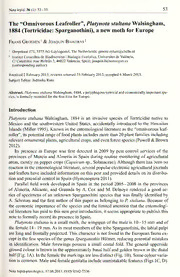
The "omnivorous Leafroller", Platynota Stultana Walsingham, 1884 (Tortricidae: Sparganothini), a New Moth for Europe PDF
Preview The "omnivorous Leafroller", Platynota Stultana Walsingham, 1884 (Tortricidae: Sparganothini), a New Moth for Europe
Notalepid.36(l): 53-55 53 The "Omnivorous Leafroller", Platynota stultana Walsingham, 1884 (Tortricidae: Sparganothini), a new moth for Europe & Frans Groenen Joaquin Baixeras^ ' ' Dorpstraat 171, 5575AGLuyksgestel, TheNetherlands; [email protected] 2 InstitutCavanillesdeBiodiversitati Biologia Evolutiva, UniversitätdeValència, ClCatedràtic Jose Beltrân2,46022 Valencia, Spain;[email protected] (correspondingauthor) Received2 February2013; reviewsreturned25 February2013; accepted6 March2013. SubjectEditor: JadrankaRota. Abstract.PlatynotastultanaWalsingham, 1884,apolyphagoustortricidandeconomicallyimportantspe- cies, is formallyrecordedforthefirsttime forEurope. Introduction Platynota stultana Walsingham, 1884 is an invasive species of Tortricidae native to Mexico and the southwestern United States, accidentally introduced to the Hawaiian Islands (Miller 1995). Known in the entomological literature as the "omnivorous leaf- roller", its potential range offood plants includes more than 20 plant families including relevantornamentalplants, agricultural crops, andeven forestspecies (Powell & Brown 2012). Its presence in Europe was first detected in 2009 by pest control services of the provinces of Murcia and Almeria in Spain during routine monitoring of agricultural areas, mostly on pepper crops {Capsicum sp., Solanaceae). Although there has been no reaction in the entomological literature, several popularelectronic agriculturaljournals and leaflets have included information on this pest and provided details on its distribu- tion and potential control in Spain (Hymenoptera 2011). Parallel field work developed in Spain in the period 2005-2008 in the provinces ofAlmeria, Alicante, and Granada by A. Cox and M. Delnoye rendered a good se- ries ofspecimens ofan unknown Sparganothini species that was finally identified by A. Schreurs and the first author ofthis paper as belonging to P. stultana. Because of the economic importance ofthe species and the limited attention that the entomologi- cal literature has paid to this new pest introduction, it seems appropriate to publish this note to formally record its presence in Spain. mm Platynota stultana is a small moth, the wingspan ofthe male is 10-15 and of the female 14-19 mm. As in most members ofthe tribe Sparganothini, the labial palpi are long and frontally projected. This character is not found in the European fauna ex- cept in the few species ofthe genus Sparganothis Hübner, reducing potential mistakes in identification. Male forewings possess a small costal fold. The general upperside ground colour is brown in the approximately basal halfand golden brown in the distal half(Fig. 1A). Inthe femalethe markings are less distinct(Fig. IB). Some colourvaria- tion is common. Male and female genitalia include unmistakable features (Figs IC, D). Notalepidopterologica, 17.06.2013,ISSN0342-7536 54 Groenen &Baixeras: Platynotastultana Fig. 1.Platynotastultana. A: Male(CabodeGata,Almeria, Spain). B: Female(Granada, Spain). C: Male genitalia(GS: FG2409). D: Femalegenitalia(GS: FG2408). Detailed information on its morphology and biology is compiled by Powell & Brown (2012). IntheUnited States the mothhas 4-6 generations ayear. The female lays apatchof about 100 eggs. After hatching the larvae move to the top ofthe plant and feed within a bud or between the two leaves. In greenhouse conditions the larvae are fully grown within a period of 20-30 days. They hibernate between the third and fifth instar in webbed nests. Pupation takes place in a rolled leaf Material. Spain,29specimens,Almeria,AquaDulce,x.2005,leg.AC; 3 specimens,Alicante,LaMa- rina,leg. MD; 18specimens,Almeria,CabodeGata,vi.2007;5 specimens,samelocalitybutdatedx.2007; 82 specimens, Granada, Castillio de Banos, x.2008, genitalia slides FG2138cr, FG2354Ç, FG2355cr; 10 specimens, same localitybutdatedvi.2010; 1 specimen, xi.2011 [GNL,AS,AC]. Notalepid.36(1): 53-55 55 Abbreviations AS CollectionA. Schreurs, Kerki^ade,TheNetherlands AC CollectionA. Cox, Mook,TheNetherlands GNL CollectionF. Groenen, Luyksgestel, TheNetherlands MD CollectionM. Delnoye, Susteren,TheNetherlands Acknowledgements The authors want to express their gratitude to John Brown (USDA, Washington, USA), Tomas Cabello (University ofAlmeria, Spain), Anton Cox and Martin Delnoye (The Netherlands), Ferran Garcia-Mari (Polytechnic University ofValencia, Spain), Arnold Schreurs (The Netherlands), Marja von der Straten (PlantProtectionService,TheNetherlands), andBoyanZlatkov(SofiaUniversity, Bulgaria) fortheircol- lections, information, andhelpfulcomments. References Miller, S. E. 1995.Platynotastultana,theomnivorous leafroller, establishedintheHawaiianIslands (Le- pidoptera: Tortricidae). -BishopMuseumOccasional Papers42: 36-39. Powell, J. A. & J. W. Brown 2012. The Moths ofNorthAmerica. Fascicle 8.1, Tortricoidea, Tortricidae (Part), Sparganothini and Atterini. - The Wedge Entomological Research Foundation, Washington, 229pp. Hymenoptera2011. Platynotastultana, un nuevo lepidoptero plaga en el sudeste espanol. - Homo agri- cola, 1: 33-38.
